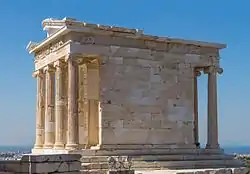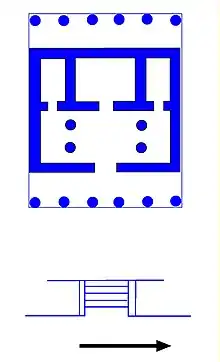Amphiprostyle
In classical architecture, amphiprostyle (from the Greek ἀμφί (amphi), on both sides, and πρόστυλος (prostylos), a portico) denotes an ancient temple with a portico both at the front and the rear,[1] where the columns on the narrow sides are not between antae.[2] The number of columns rarely exceeded four in the front and four in the rear. The best-known example is the tetrastyle small Temple of Athena Nike at Athens. Other known examples are the Temple of Artemis Agrotera outside Athens,[3] and the hexastyle Temple of the Athenians at Delos.[4]

Northeast view of the Temple of Athena Nike, a amphiprostyle temple.

Plan of the temple at Jebel Khalid
Amphiprostyle temples without columns on the sides may be termed "apteral" (from the Greek απτερος, "wingless": α-, "without" + πτερον, "wing"). The Athena Nike temple is one such example.[5]
Notes
-
 One or more of the preceding sentences incorporates text from a publication now in the public domain: Chisholm, Hugh, ed. (1911). "Amphiprostyle". Encyclopædia Britannica. 1 (11th ed.). Cambridge University Press. p. 891.
One or more of the preceding sentences incorporates text from a publication now in the public domain: Chisholm, Hugh, ed. (1911). "Amphiprostyle". Encyclopædia Britannica. 1 (11th ed.). Cambridge University Press. p. 891. - White 1990, p. 50.
- "Ναός Αργοτέρας Αρτέμιδος - Welcome". www.artemisagrotera.org.
- "Delos, Athenian Temple of Apollo (Building)". www.perseus.tufts.edu.
-
 One or more of the preceding sentences incorporates text from a publication now in the public domain: Chisholm, Hugh, ed. (1911). "Apteral". Encyclopædia Britannica. 2 (11th ed.). Cambridge University Press. p. 234.
One or more of the preceding sentences incorporates text from a publication now in the public domain: Chisholm, Hugh, ed. (1911). "Apteral". Encyclopædia Britannica. 2 (11th ed.). Cambridge University Press. p. 234.
References
 This article incorporates text from a publication now in the public domain: Chambers, Ephraim, ed. (1728). Cyclopædia, or an Universal Dictionary of Arts and Sciences (1st ed.). James and John Knapton, et al. Missing or empty
This article incorporates text from a publication now in the public domain: Chambers, Ephraim, ed. (1728). Cyclopædia, or an Universal Dictionary of Arts and Sciences (1st ed.). James and John Knapton, et al. Missing or empty |title=(help)
Sources
- White, Antony (1990). Architecture & Ornament: A Visual Guide (1st U.S. ed.). New York: Design Press. pp. 50. ISBN 0-8306-3352-9.CS1 maint: ref=harv (link)
This article is issued from Wikipedia. The text is licensed under Creative Commons - Attribution - Sharealike. Additional terms may apply for the media files.